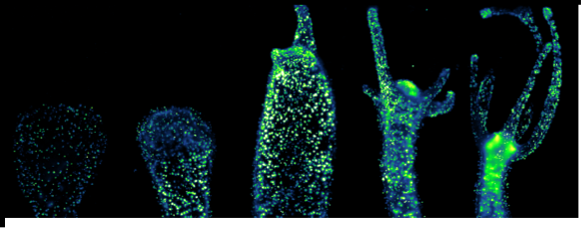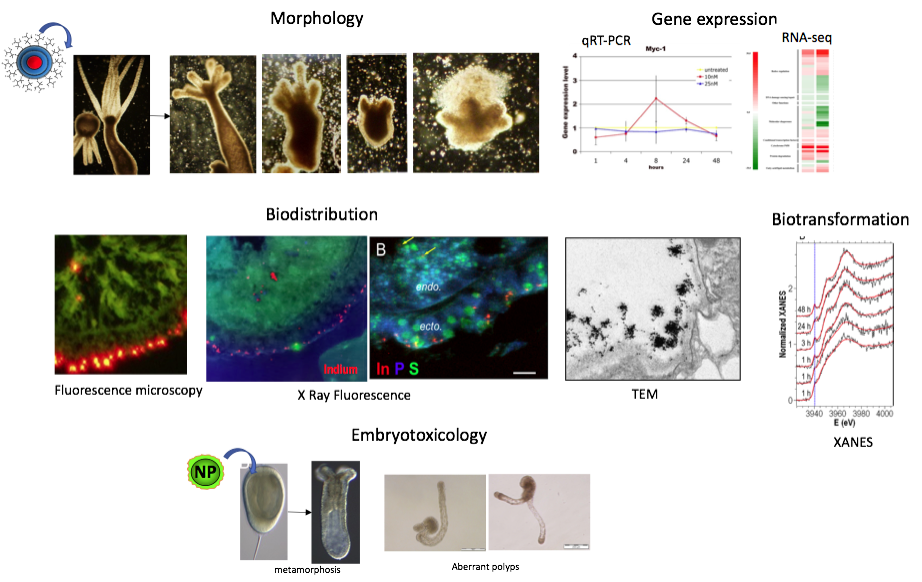






NanoBiomolecular Group
Istituto di Scienze Applicate e Sistemi Intelligenti “E.Caianiello”
CONSIGLIO NAZIONALE DELLE RICERCHE



ENVIRONMENTAL toxicology
The high sensitivity to heavy metals and organic compounds makes Cnidaria amenable models for biosensing pollutant’s toxicity in natural ecosystems, modeling biological barriers for their absorption, biodistribution, and persistency in the food chain. We have developed an integrated multilevel analysis profiling the biosafety and toxicity of diverse toxicants in aquatic environments, focusing on inorganic metal based nanoparticles as models of modern environmental pollutants, unintentionally released from antropogenic sources through powder/water waste-stream. We adopted the polyp Hydra vulgaris and the starlet sea anemone Nematostella vectensis as biosensors of freshwater and estuarine ecosystems, respectively, and measured several toxicity endpoints of many different nanoparticles (Cd-based QDs [1-3], carbon nanoonions [4], silica NPs [5-6], In-based QDs[7]). Starting from in vivo morphometric analysis and dose response effects we measure the regenerative and reproductive rates of treated animals, evaluate cell proliferation and apoptotic rates, assess the internalization routes using electron microscopy where possible, up to the gene profiling (qRT-PCR or RNA-seq) to dissect the molecular mechanisms underlying toxicity. Moreover, the possibility offered by Nematostella to induce gametogenesis allows to treat precise developmental stages and assess the embryotoxic effect of a given nanostressor and the transgenerational effect [7]. The long-term toxicity effects are further investigated by spectroscopic analysis [8], addressing not only the persistence of hazardous metals into the tissue, but the biochemical transformation and speciation occurring in vivo, paving the way to new perspectives on nanomaterial life-cycle for a sustainable use

Go to: RESEARCH
Collaborations
Alfredo Ambrosone Department of Pharmacy, Biomedical division, University of Salerno
Giulia Veronesi, Laboratoire de Chimie et Biologie des Métaux, CEA-Grenoble, France
H. Castillo-Michel, European Synchroton Radiation Facility, Grenoble, France
Ilaria Rea, Istituto di Scienze Applicate e Sistemi Intelligenti, sez. Napoli
Peter Reiss, SYstèmes Moléculaires et nanoMatériaux pour l’Energie et la Santé Équipe Synthèse- CEA, Grenoble, France
[1] Ambrosone, A.; Mattera, L.; Marchesano, V.; Quarta, A.; Susha, A. S.; Tino, A.; Rogach, A. L.; Tortiglione, C. Mechanisms Underlying Toxicity Induced by CdTe Quantum Dots Determined in an Invertebrate Model Organism. Biomaterials 2012, 33, 1991−2000.
[2] Ambrosone, A.; Roopin, M.; Pelaz, B.; Abdelmonem, A. M.;Ackermann, L.-M.; Mattera, L.; Allocca, M.; Tino, A.; Klapper, M.;Parak, W. J.; Levy, O.; Tortiglione, C. Dissecting Common and Divergent Molecular Pathways Elicited by CdSe/ZnS Quantum Dots in Freshwater and Marine Sentinel Invertebrates. Nanotoxicology 2017, 11, 289−303.
[3] Allocca, M.; Mattera, L.; Bauduin, A.; Miedziak, B.; Moros, M.; De Trizio, L.; Tino, A.; Reiss, P.; Ambrosone, A.; Tortiglione, C. An Integrated Multilevel Analysis Profiling Biosafety and Toxicity Induced by Indium- and Cadmium-Based Quantum Dots in Vivo. Environ. Sci. Technol. 2019, 53, 3938−3947.
[4] Marchesano, V.; Ambrosone, A.; Bartelmess, J.; Strisciante, F.; Tino, A.; Echegoyen, L.; Tortiglione, C.; Giordani, S. Impact of Carbon Nano-Onions on Hydra Vulgaris as a Model Organism for Nanoecotoxicology. Nanomaterials 2015, 5, 1331−1350.
[5] Ambrosone, A.; Scotto di Vettimo, M. R.; Malvindi, M. A.;Roopin, M.; Levy, O.; Marchesano, V.; Pompa, P. P.; Tortiglione, C.;Tino, A. Impact of Amorphous SiO2 Nanoparticles on a Living Organism: Morphological, Behavioral, and Molecular Biology
Implications. Front. Bioeng. Biotechnol. 2014, 2, 37.
[6] Terracciano, M., De Stefano, L., Tortiglione, C., Tino, A., Rea, I. In Vivo Toxicity Assessment of Hybrid Diatomite Nanovectors Using Hydra vulgaris as a Model System Adv. Biosys. 2019, 3, 1800247
[7] Ambrosone A, Marchesano V, Mazzarella V, Tortiglione C. Nanotoxicology using the sea anemone Nematostella vectensis: from developmental toxicity to genotoxicology. Nanotoxicology. 2014 8(5):508-20
[8] G. Veronesi, M. Moros, H. Castillo-Michel, L. Mattera, G. Onorato, K.D. Wegner, W. L. Ling, P. Reiss, C. Tortiglione, In vivo biotransformations of indium phosphide quantum dots revealed by X-ray microspectroscopy, ACS Appl. Mater. Interfaces 2019, 11, 35630–35640.
Relevant publications